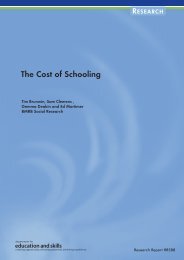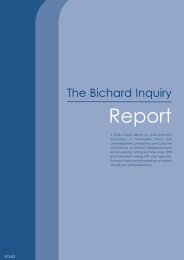The Learning and Skills Councils Annual Report and Accounts for ...
The Learning and Skills Councils Annual Report and Accounts for ...
The Learning and Skills Councils Annual Report and Accounts for ...
You also want an ePaper? Increase the reach of your titles
YUMPU automatically turns print PDFs into web optimized ePapers that Google loves.
Unaudited<br />
in<strong>for</strong>mation<br />
Salary<br />
For the purposes of the analysis,<br />
‘salary’ includes the following where<br />
applicable:<br />
gross salary payable<br />
compensation or redundancy<br />
per<strong>for</strong>mance pay or bonuses<br />
other allowances, <strong>and</strong><br />
• overtime payable.<br />
Benefits in kind<br />
<strong>The</strong> monetary value of benefits in kind<br />
covers any benefits provided by the<br />
employer <strong>and</strong> treated by HM Revenue<br />
<strong>and</strong> Customs as a taxable emolument.<br />
<strong>The</strong> benefits provided by the LSC<br />
to national <strong>and</strong> regional directors<br />
disclosed on the previous pages relate<br />
to lease cars.<br />
Civil Service pensions<br />
Pension benefits are provided through<br />
the Civil Service pension arrangements.<br />
From 1 October 2002, civil servants<br />
may be in one of three statutory-based<br />
‘final salary’ defined benefit schemes<br />
(classic, premium <strong>and</strong> classic plus). <strong>The</strong><br />
schemes are unfunded, with the cost<br />
of benefits met by monies voted by<br />
Parliament each year. Pensions payable<br />
under classic, premium <strong>and</strong> classic<br />
plus are increased annually in line<br />
with changes in the Retail Prices Index.<br />
New entrants after 1 October 2002<br />
may choose to join either premium<br />
or a good-quality ‘money purchase’<br />
stakeholder arrangement with a<br />
significant employer contribution<br />
(partnership pension account).<br />
Employee contributions are set at the<br />
rate of 1.5 per cent of pensionable<br />
earnings <strong>for</strong> classic <strong>and</strong> 3.5 per cent<br />
<strong>for</strong> premium, nuvos <strong>and</strong> classic plus.<br />
Benefits in classic accrue at the rate of<br />
1/80th of pensionable salary <strong>for</strong> each<br />
year of service. In addition, a lump sum<br />
equivalent to three years’ pension is<br />
payable on retirement. For premium,<br />
benefits accrue at the rate of 1/60th<br />
of final pensionable earnings <strong>for</strong> each<br />
year of service. Unlike classic, there is<br />
no automatic lump sum (but members<br />
may give up (commute) some of<br />
their pension to provide a lump sum).<br />
Classic plus is essentially a variation of<br />
premium, but with benefits in respect<br />
of service be<strong>for</strong>e 1 October 2002<br />
calculated broadly as per classic.<br />
Nuvos is a relatively new defined<br />
benefit scheme where employee<br />
contributions are currently at<br />
3.5 per cent of pensionable pay.<br />
Pension benefits build up at the rate<br />
of 2.3 per cent of pensionable earnings<br />
per annum <strong>and</strong> the option is available<br />
at retirement to convert up to<br />
25 per cent of total notional pension<br />
benefits into a lump sum.<br />
<strong>The</strong> partnership pension account is a<br />
stakeholder pension arrangement. <strong>The</strong><br />
employer makes a basic contribution<br />
of between 3 per cent <strong>and</strong> 12.5 per<br />
cent (depending on the age of the<br />
member) into a stakeholder pension<br />
product chosen by the employee. <strong>The</strong><br />
employee does not have to contribute,<br />
but where they do make contributions,<br />
the employer will match these up to<br />
a limit of 3 per cent of pensionable<br />
salary (in addition to the employer’s<br />
basic contribution). Employers also<br />
contribute a further 0.8 per cent of<br />
pensionable salary to cover the cost<br />
of centrally provided risk benefit<br />
cover (death in service <strong>and</strong> ill-health<br />
retirement).<br />
Further details of the Civil Service<br />
pension arrangements can be found at<br />
civilservice-pensions.gov.uk.<br />
Cash equivalent<br />
transfer values<br />
A cash equivalent transfer value (CETV)<br />
is the actuarially assessed capitalised<br />
value of the pension scheme benefits<br />
accrued by a member at a particular<br />
point in time. <strong>The</strong> benefits valued<br />
are the member’s accrued benefits<br />
<strong>and</strong> any contingent spouse’s pension<br />
payable from the scheme. A CETV is a<br />
payment made by a pension scheme<br />
or arrangement to secure pension<br />
benefits in another pension scheme or<br />
arrangement when the member leaves<br />
a scheme <strong>and</strong> chooses to transfer the<br />
benefits accrued in their <strong>for</strong>mer scheme.<br />
<strong>The</strong> pension figures shown relate to<br />
the benefits that the individual has<br />
accrued as a consequence of their total<br />
membership of the pension scheme,<br />
not just their service in a senior<br />
capacity to which disclosure applies.<br />
<strong>The</strong> CETV figures (<strong>and</strong>, from 2003–04,<br />
the other pension details) include<br />
the value of any pension benefit in<br />
another scheme or arrangement that<br />
the individual has transferred to the<br />
Civil Service pension arrangements<br />
30 LSC <strong>Annual</strong> <strong>Report</strong> <strong>and</strong> <strong>Accounts</strong> 2009–10
















